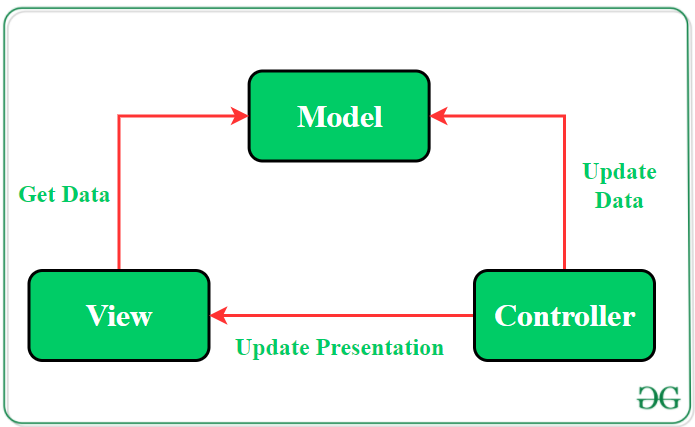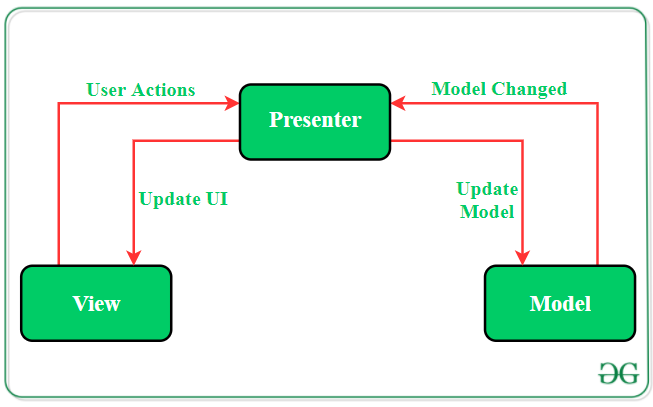通过应用软件架构模式开发 android 应用程序始终是开发人员的首选。架构模式为项目文件提供了模块化,并确保所有代码都包含在单元测试中。它使开发人员可以轻松地维护软件并在未来扩展应用程序的功能。 MVC(Model-View-Controller)、MVP(Model-View-Presenter)和MVVM(Model-View-ViewModel)是开发者中最流行和业界认可的Android架构模式。
模型—视图—控制器(MVC)模式
MVC 模式建议将代码拆分为 3 个组件。在创建应用程序的类/文件时,开发人员必须将其分类为以下三层之一:
- 模型:此组件存储应用程序数据。它对接口一无所知。该模型负责处理领域逻辑(现实世界的业务规则)以及与数据库和网络层的通信。
- 视图:它是 UI(用户界面)层,其中包含在屏幕上可见的组件。此外,它提供存储在模型中的数据的可视化,并为用户提供交互。
- 控制器:该组件建立视图和模型之间的关系。它包含核心应用程序逻辑并获知用户的响应并根据需要更新模型。

模型—视图—演示者(MVP)模式
MVP 模式克服了 MVC 的挑战,并提供了一种构建项目代码的简单方法。 MVP 被广泛接受的原因是它提供了模块化、可测试性以及更干净和可维护的代码库。它由以下三个部分组成:
- 模型:用于存储数据的层。它负责处理域逻辑(现实世界的业务规则)以及与数据库和网络层的通信。
- 视图: UI(用户界面)层。它提供数据的可视化并跟踪用户的操作以通知演示者。
- Presenter:从模型中获取数据并应用 UI 逻辑来决定要显示的内容。它管理视图的状态并根据用户从视图输入的通知采取行动。

模型 — 视图 — 视图模型 (MVVM) 模式
MVVM 模式与 MVP(Model — View — Presenter) 设计模式有一些相似之处,因为 ViewModel 扮演 Presenter 角色。然而,MVP 模式的弊端已经被 MVVM 解决了。它建议将数据呈现逻辑(视图或 UI)与应用程序的核心业务逻辑部分分开。 MVVM 的独立代码层是:
- Model:这一层负责数据源的抽象。 Model 和 ViewModel 协同工作以获取和保存数据。
- View:这一层的目的是通知 ViewModel 用户的操作。该层观察 ViewModel,不包含任何类型的应用程序逻辑。
- ViewModel:它公开那些与视图相关的数据流。此外,它充当模型和视图之间的链接。

MVC、MVP 和 MVVM 设计模式的区别
|
MVC(MODEL VIEW CONTROLLER) |
MVP(MODEL VIEW PRESENTER) |
MVVM(MODEL VIEW VIEWMODEL) |
|---|---|---|
| One of the oldest software architecture | Developed as the second iteration of software architecture which is advance from MVC. | Industry-recognized architecture pattern for applications. |
| UI(View) and data-access mechanism(Model) are tightly coupled. | It resolves the problem of having a dependent View by using Presenter as a communication channel between Model and View. | This architecture pattern is more event-driven as it uses data binding and thus makes easy separation of core business logic from the View. |
| Controller and View exist with the one-to-many relationship. One Controller can select a different View based upon required operation. | The one-to-one relationship exists between Presenter and View as one Presenter class manages one View at a time. | Multiple View can be mapped with a single ViewModel and thus, the one-to-many relationship exists between View and ViewModel. |
| The View has no knowledge about the Controller. | The View has references to the Presenter. | The View has references to the ViewModel |
| Difficult to make changes and modify the app features as the code layers are tightly coupled. | Code layers are loosely coupled and thus it is easy to carry out modifications/changes in the application code. | Easy to make changes in the application. However, if data binding logic is too complex, it will be a little harder to debug the application. |
| User Inputs are handled by the Controller. | The View is the entry point to the Application | The View takes the input from the user and acts as the entry point of the application. |
| Ideal for small scale projects only. | Ideal for simple and complex applications. | Not ideal for small scale projects. |
| Limited support to Unit testing. | Easy to carry out Unit testing but a tight bond of View and Presenter can make it slightly difficult. | Unit testability is highest in this architecture. |
| This architecture has a high dependency on Android APIs. | It has a low dependency on the Android APIs. | Has low or no dependency on the Android APIs. |
| It does not follow the modular and single responsibility principle. | Follows modular and single responsibility principle. | Follows modular and single responsibility principle. |
想要一个更快节奏和更具竞争力的环境来学习 Android 的基础知识吗?
单击此处前往由我们的专家精心策划的指南,旨在让您立即做好行业准备!